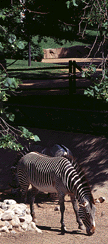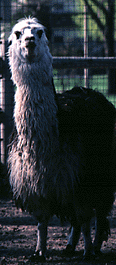Lincoln Park Zoo's four-acre Antelope and Zebra Area is home
to hoofed mammals, including camels, zebras, antelopes, and alpacas who
graze in the shade of century-old trees in ten outdoor habitats.

In the wild, hoofed mammals spend their lives in herds, constantly
moving in nomadic wanderings over their territory or in long seasonal journeys
related to food supply and reproduction. Equipped with large ears that rotate
to hear in every direction, big eyes that create a wide field of vision
and long legs with hard hooves that help them run fast, they often stay
one jump ahead of natural enemies, such as cheetahs and lions.
Unfortunately, poachers and a burgeoning human population have forced
many hoofed mammal species to the brink of extinction. It is only with the
assistance of zoos like Lincoln Park that some of these animals survive.

==>> Conservation Spotlight--The
Arabian Oryx.
Species Data Sheets:
|

 Zebra stripes, like human fingerprints, are unique
to each individual. It is theorized that the black on white markings help
protect zebras. Merged as a herd, all the zebra's stripes blend together,
making it visually confusing for natural predators to single out and kill
an individual. Zebra stripes, like human fingerprints, are unique
to each individual. It is theorized that the black on white markings help
protect zebras. Merged as a herd, all the zebra's stripes blend together,
making it visually confusing for natural predators to single out and kill
an individual.
Sadly, zebras are no match for human predators, who kill them for their
beautiful striped coats that fetch high prices. Wild populations in their
native Africa have been so drastically reduced that zebras have become critically
endangered. Lincoln Park Zoo has made a long-term commitment to the conservation
and propagation of this beautiful and exotic animal by cooperating in the
SSP for the Grevy's zebra.

|

| Contrary to popular belief, camels do not store water in their humps. Both
the one-humped dromedary and the two-humped Bactrian camels actually
store energy-rich fats in the humps, which their bodies can draw upon for
nutrients when food is scarce. Wonderfully adapted for life in the desert,
the camel's closable nostrils, heavy eyebrows and eyelashes provide valuable
protection in severe sandstorms. They can also go for up to 10 months without
drinking water! When they do drink, they can consume up to 30 gallons of
water at one time. Once prevalent in Mongolia and parts of China, now less
than 1,000 Bactrian camels exist in the wild. |

| African natives Grant's gazelles and sable antelopes are among the
fastest animals on land, sprinting up to 50 miles an hour! For the short
distance they cannot outrun a cheetah (who can accelerate to 60 miles per
hour), but by bouncing and then running, these graceful antelopes may manage
to avoid the cheetah until the big cat tires and gives up the chase. |

 Alpaca wool is the finest of any animal fleece.
In fact, these South American members of the camel family are selectively
bred to produce the best quality of wool. Many textiles made from the long,
silky alpaca wool include blankets, coats, and sweaters. Domesticated since
pre-Columbian times, today no alpacas live independently of humans. Alpaca wool is the finest of any animal fleece.
In fact, these South American members of the camel family are selectively
bred to produce the best quality of wool. Many textiles made from the long,
silky alpaca wool include blankets, coats, and sweaters. Domesticated since
pre-Columbian times, today no alpacas live independently of humans.
Photo © James P. Rowan Photography |
|


